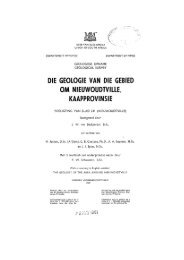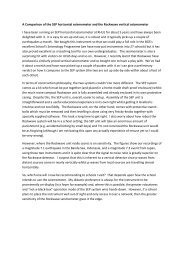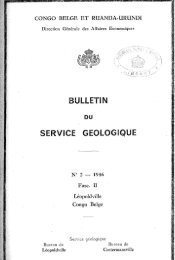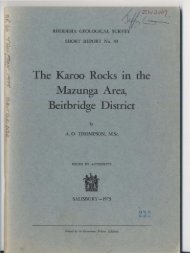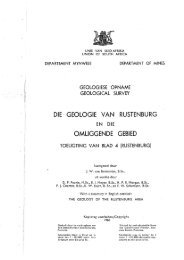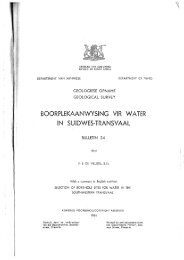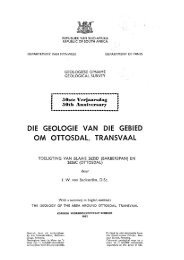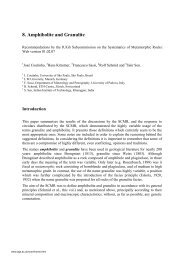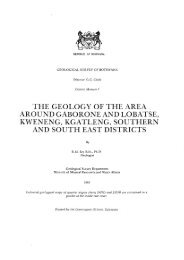Bibliography - British Geological Survey
Bibliography - British Geological Survey
Bibliography - British Geological Survey
Create successful ePaper yourself
Turn your PDF publications into a flip-book with our unique Google optimized e-Paper software.
Moir, J. R. 1920. Pre-Palæolithic man. 67 pp, 29 plates.<br />
Moir, J. R. 1938. The Piltdown bone implement. Nature, 141 (supplement, 21 May), 926. (With reference<br />
to the opinion of Breuil 1938 that the Piltdown bone implement is the result of gnawing by carnivores or<br />
rodents, the writer points out that he has successfully cut bone using flint tools, which produces the same<br />
kind of stepped fracture as that shown by the Piltdown implement. See also Woodward 1938)<br />
Molleson, T. (see under Farrar 1981, & Lowenstein et el. 1982)<br />
Montagu, M. F. A. 1951a. The Barcombe Mills cranial remains. American Journal of Physical Anthropology,<br />
new ser, 9, 417–426.<br />
Montagu, M. F. A. 1951b. The Piltdown mandible and cranium. American Journal of Physical Anthropology,<br />
new ser, 9, 464–470, plates 1–2. (Having had the opportunity to examine the original human remains from<br />
Piltdown, the writer has been greatly struck by the marked disparity in massiveness between the Piltdown<br />
mandible and cranium, such as to make it highly improbable that the two belong together. This lack of<br />
morphological congruity had already been noted by Hrdlička in1922.)<br />
Montagu, M. F. A. 1954. The Piltdown nasal turbinate and bone implements: some questions. Science, 119<br />
(18 June), 884–886. (Having examined the Piltdown bones in 1951, Prof. Montagu of the Department of<br />
Anthropology, Rutgers University, questions the presence of portions of a turbinate, which under normal<br />
circumstances is too fragile to survive in the fossil record. He also thinks that the alleged ‘bone implement’<br />
was carved by ‘a sharp metal blade probably of the Sheffield steel variety’.)<br />
Montagu, M. F. A. 1960a. An introduction to physical anthropology. 3rd ed. Springfield: Thomas Books.<br />
(The Piltdown hoax: reprinted in The origin and evolution of man, by the same author, 1971, pp. 211–215.)<br />
Montagu, M. F. A. 1960b. Artificial thickening of bone and the Piltdown skull. Nature, 187 (9 July), 174.<br />
(Given the unusual thickness of the Piltdown skull, the writer suggests that immersion in potassium<br />
hydroxide or some other similar chemical treatment might have been employed by the forger to artificially<br />
thicken the skull. A reply by K. P. Oakley, which follows the correspondence from Montagu, states that<br />
there is no evidence for such treatment, but in the <strong>British</strong> Museum collections there are examples of other<br />
crania as thick as that from Piltdown, e.g. an Ona Indian from Tierra del Fuego, and a Bronze Age example<br />
from Sutton Courtenay in Berkshire.)<br />
Moore, R. 1955. Man, time and fossils: the story of evolution. London: Readers Union, Jonathan Cape,<br />
382 pp. (Ch. 17: Oakley – fluorine and the age of early man, pp. 304–323, 2 plates. After describing 19thcentury<br />
observations on the absorption of fluorine by fossil bones and teeth, the author goes on to record<br />
how ‘two unrelated events during World War II revived interest in the old fluorine data. The <strong>Geological</strong><br />
<strong>Survey</strong> of Great Britain undertook a survey of the phosphate resources of the country, and also a study of the<br />
effect of fluorinated water in reducing tooth decay in children.’ Kenneth Oakley was assigned to the work on<br />
temporary transfer from the Natural History Museum. As he delved into the history of fluorine in groundwater<br />
[in conjunction with C. E. N. Bromehead] he saw how it might be applied to the relative dating of bones of<br />
different ages that might have become mixed together in the same deposit. See Eastwood & Oakley 1953)<br />
Morell, V. 1995. Ancestral passions: the Leakey family and the quest for humankind’s beginnings. New<br />
York: Simon & Schuster. (Notes that Louis Leakey’s notes and unfinished book draft about Teilhard’s<br />
supposed complicity in the Piltdown affair have been deposited in the archives of the National Museums of<br />
Kenya, pp. 378–379, 394)<br />
Moriarty, J. 1983. Piltdown debate: not so elementary. Science 83, 4 (9), 24. (‘I have just read, with no<br />
light interest, the case made against Sir Arthur C. Doyle in your September issue. Although Winslow and<br />
Meyer did a fine job of research, they are totally incorrect. Once more, I have succeeded!’)<br />
Morris, H. 1929. An exhibit of Sussex flint implements of the Piltdown Man period. South-Eastern<br />
Naturalist and Antiquary, 34th Annual Congress, Brighton, June 1929, lxiii. (Notice only, recording<br />
‘a large collection of flints arranged by Mr. H. Morris, with illustrations and correspondence.’)<br />
Morris, H. (With respect to Harry Morris’s accusation of fraud made against Charles Dawson in connection<br />
with the Piltdown ‘palaeoliths’, see discussion in Weiner 1955b, 154–161)<br />
Morwood, M. & van Oosterzee, P. 2007. A new human: the startling discovery and strange story of the<br />
“Hobbits” of Flores, Indonesia. Washington: Smithsonian Books/HarpurCollins, 256 pp. (‘In October



